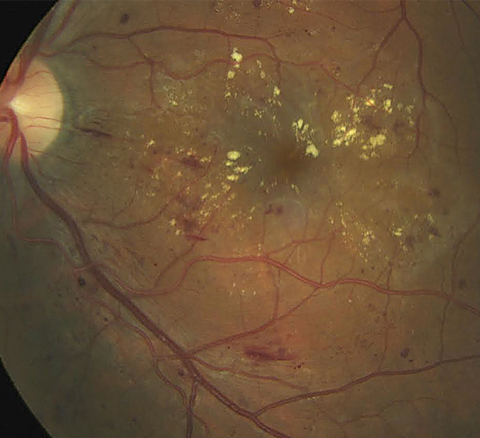 |
|
Serum protein loss in kidney disease can raise hydrostatic pressure, causing fluid retention in the subretinal space that can lead to DME, the researchers posited. Photo: Jarett Mazzarella, OD. Click image to enlarge. |
Editor’s Note: As part of our “Year in Review” retrospective, we’ve selected the top 30 news stories of the year and are re-sharing them as we close out 2022. Follow along as we count down to number 1!
This story was originally published on December 16, 2022.
No. 6 biggest news story of 2022:
While diabetic macular edema comes (DME) with the risk of developing subretinal fluid (SRF), the association between DME, abnormal renal profiles and development of SRF is less well explored. One new study examined just that, looking at potential risk factors for fluid development and linking it with renal function, since diabetic kidney disease and DME may share similar microvascular pathophysiology.
The retrospective study included 66 DME patients and the researchers evaluated systemic and renal parameters along with ocular factors. Systemic parameters included hypertension, glycosylated hemoglobin, serum fasting glucose diabetic kidney disease and others. Renal parameters included serum albumin, albuminuria and estimated glomerular filtration rate. OCT measured for things like central subretinal fluid thickness and presence of SRF.
Main findings from the research included a higher albuminuria level association with the presence of SRF in DME patients and lower serum albumin levels associated with an increase in SRF thickness.
In line with these results, the researchers suggest that “diabetic kidney disease plays an important role in the occurrence of SRF in DME.” They additionally mention that higher albuminuria had a better association with SRF presence than HbA1c levels, but that both were in fact important risk factors when determining SRF presence. Even further, serum albumin was not significantly different between patients with and without SRF.
As for why an observed negative correlation was observed between SRF severity and serum albumin levels, the researchers postulate that the connection might be due to a shared pathogenic mechanism between the kidney (albuminuria) and the eye (SRF), that being vascular hyperpermeability.
As pressure gradients determine fluid movement, lower intravascular osmotic pressure and higher hydrostatic pressure may result from marked protein loss seen in advanced proteinuria. As such, fluid retention of the subretinal space would occur, and in early stages, increased albumin molecule production in the liver would serve as a compensatory mechanism for deficits of serum albumin. At later stages, though, the serum deficits that could not be compensated for could be associated with the observed SRF thickness.
The researchers believe fluid leakage from choroidal vessels may be more prone to patients with albuminuria, as well as a damaged retinal pigment epithelium, leading to the SRF seen in DME.
Finally, they point out that a lower HbA1c level was more likely to result in SRF, contrary to what some might think. This may be due to an early worsening effect caused by rapid HbA1c level reduction.
Because of the apparent connection between DME and renal capacity, the authors of the study advise that “screening for SRF in DME in all patients with diabetic kidney disease should be emphasized” and screening “patients with higher albuminuria and lower serum albumin levels should be routinely performed.”
Zhang X, Hao X, Wang L, Xie L. Association of abnormal renal profiles with subretinal fluid in diabetic macular edema. J Opthalmol. December 13, 2022. [Epub ahead of print]. |


